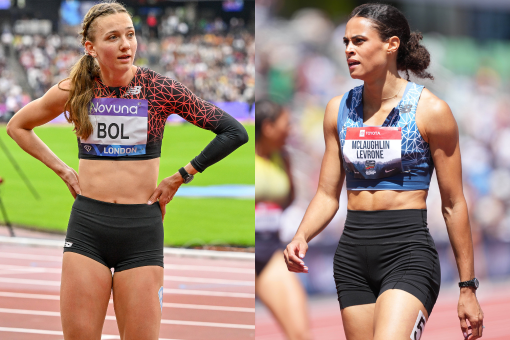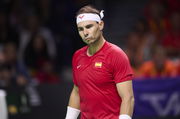
Imago
Sydney McLaughlin-Levrone and Femke Bol/ Image Credits: Imago

Imago
Sydney McLaughlin-Levrone and Femke Bol/ Image Credits: Imago
Sydney McLaughlin-Levrone has never been one to linger in one lane. After conquering the 400-meter hurdles with world records and Olympic titles, she has stepped decisively into the 400 flat, winning the national championship in Eugene with a commanding 48.90. Her shift, born out of the same relentless competitiveness that once made her dismiss golf for being a game she could not instantly master, has carried her close to Sanya Richards-Ross’ American record of 48.70 and positioned her for a new chapter on the track.
Watch What’s Trending Now!
The transition has been seamless in some respects. McLaughlin-Levrone has already collected a U.S. crown in the 400, stating, “Everyone talks about the American record, of course, but that’s going to come when it’s going to come.” She emphasized patience and growth in the event, adding, “I’ve learned a lot about myself and I’ve learned a lot about the 400.” It is a statement of intent from an athlete whose best in the hurdles, 50.37 at the Paris Games last year, has altered the history of the event.
Yet while McLaughlin-Levrone has shifted events, Femke Bol has consolidated her dominance. The Dutch athlete claimed her fifth consecutive Diamond League title in the 400 hurdles at the Zurich Final on August 28, setting a meeting record of 52.18. That victory extended her unbeaten run in the Diamond League since 2020 and marked her 30th successive win in the series. Bol now owns five Diamond League crowns to McLaughlin-Levrone’s one, earned in 2019. Even though McLaughlin-Levrone holds the global records and Olympic honors, Bol has built an unbroken legacy in the sport’s premier circuit.
ADVERTISEMENT
Bol’s record in Zurich underscored that authority. She crossed the line a full second ahead of Slovakia’s Emma Zapletalova, who ran a national record of 53.18 for second place, while Jamaica’s Andrenette Knight finished third in 53.76. The consistency is unmatched.
Meeting record for Femke Bol!
The 🇳🇱 ace clocks 52.18 to claim a 30th #DiamondLeague win and a fifth series title in a row. #DLFinal💎#ZurichDL🇨🇭
📷 @chiaramontesan2 / @macroprophoto pic.twitter.com/roM6vrZjxp— Wanda Diamond League (@Diamond_League) August 28, 2025
Earlier this season, Bol had run 51.95 in Monaco and 52.10 in London, extending her sequence of meeting records across Europe. Her ability to repeat at the highest level has become as defining as McLaughlin-Levrone’s singular performances at the Olympic Games.
ADVERTISEMENT
Sydney McLaughlin-Levrone’s own history in the Diamond League is narrower. Alongside her 2019 title, she has collected four meeting wins but has often tailored her season to peak at the Olympic Games and World Championships. Injuries have at times interrupted her schedule, most notably in 2023 when she withdrew from the World Championships in Budapest with a minor knee issue. Nevertheless, her personal bests, 48.74 in the 400 flat and 22.07 in the 200, demonstrate range that only a handful of women have ever possessed.
The comparison, then, is less about direct contests and more about arenas of supremacy. Bol has the uninterrupted Diamond League record, McLaughlin-Levrone – the Olympic and world titles. As the World Championships in Tokyo approach, their paths may again converge, with the flat sprinter and the hurdler standing as parallel benchmarks of excellence. What is certain is that the Zurich result has tilted the balance of the conversation.
ADVERTISEMENT
Bol’s fifth crown affirms her command of the circuit, and McLaughlin-Levrone’s venture into the 400 flat has opened a new stage where she must prove herself all over again. Sydney’s move from the 400m hurdles to the flat 400m revealed both her hunger for new challenges and the disappointment it left for rival Femke Bol.
Sydney McLaughlin-Levrone’s 400m switch redefines her pursuit of greatness; however, it leaves Femke Bol disappointed
Sydney McLaughlin-Levrone’s decision to step away from the 400m hurdles at the US nationals and take on the flat 400m reflected a deliberate choice rooted in her competitive instincts. She had nothing left to prove over the barriers, holding two Olympic titles, a world crown, and the world record, yet she refused to remain in the comfort of established dominance. By shifting to the flat race, she created an entirely new test for herself, one that she pursued with the same intensity that had defined her years of hurdling excellence.
ADVERTISEMENT
“I just want to be the best that I can be when I step on the track,” she explained, framing the move as an extension of her determination to evolve rather than preserve.

Imago
Credit: Instagram
That pursuit quickly bore results in Eugene, where she captured the national title in 48.90 seconds and earned her place at the World Championships. McLaughlin-Levrone admitted the switch was “not as comfortable” for her or her team, but she insisted on welcoming the uncertainty, describing the transition as a necessary step forward. The victory in Eugene confirmed the wisdom of the risk.
ADVERTISEMENT
However, her absence in the hurdles field altered the competitive landscape for rivals, most notably Femke Bol, who openly expressed her regret that the two would not meet again in Tokyo.
Top Stories
NFL Files Motion to Dismiss Former Texans Board Member Cary McNair’s “Legally Baseless” Lawsuit

T.J. Watt’s Wife Shares Emotional Update on Steelers LB Following Worrying Health Scare

Forced to Leave FOX, Cowboys Legend Troy Aikman Says ESPN Is Like ‘U.S. Government’ & Clearly Distinguishes the Two Networks

New Charter Deal Triggers ‘Financial Frenzy’ as NASCAR Teams Set for Massive Payday

Steelers Legend Accuses Mike Tomlin of Lowering Standards as Winning Record Called Into Question

Rafael Nadal Faces New Injury Blow Only a Year After His Emotional Tennis Exit

“Maybe it’s a bit of a disappointment. It’s a shame,” Bol conceded, noting that facing McLaughlin-Levrone remained unique, even in defeat. While Bol looked toward a clearer path to another world title, McLaughlin-Levrone prepared for a new contest against Marileidy Paulino and Shaunae Miller-Uibo, showing that her ambition had expanded beyond one event and into the broader scope of sprinting history.
ADVERTISEMENT
ADVERTISEMENT
ADVERTISEMENT

